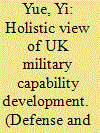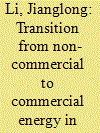|
|
|
Sort Order |
|
|
|
Items / Page
|
|
|
|
|
|
|
| Srl | Item |
| 1 |
ID:
182549


|
|
|
|
|
| Summary/Abstract |
Cost escalation for many complex defence equipment is arguably not sustainable. Customer driven requirements have led to an exponential increase in costs by pushing frontiers of technology to support primarily incremental improvements of traditional equipment concepts. Accordingly, affordability has become a more discussed subject in defence acquisition. This paper addresses the process of generating complex defence equipment concepts. The purpose is to explore how affordability is managed in that process and to identify possible leads to how an unsustainable cost escalation for this type of equipment can be curbed. This is done by studying two cases of concept generation of future combat air equipment systems from a company process perspective. This applied micro perspective on cost escalation showed that none of the concepts generated in these two cases were assessed to curb the cost escalation. Further, the innovation model for the generated concepts, with only one notable exception, was incremental. Nevertheless, the empirical observations from these two cases offer leads on how to potentially foster a more innovative and affordability-oriented concept generation process for future defence equipment, as well as indicating avenues for future research.
|
|
|
|
|
|
|
|
|
|
|
|
|
|
|
|
| 2 |
ID:
136254


|
|
|
|
|
| Summary/Abstract |
Energy security studies have expanded from their classic beginnings following the 1970s oil crises to encompass various energy sectors and increasingly diverse issues. This viewpoint contributes to the re-examination of the meaning of energy security that has accompanied this expansion. Our starting point is that energy security is an instance of security in general and thus any concept of it should address three questions: “Security for whom?”, “Security for which values?” and “Security from what threats?” We examine an influential approach – the ‘four As of energy security’ (availability, accessibility, affordability, and acceptability) and related literature of energy security – to show it does not address these questions. We subsequently summarize recent insights which propose a different concept of energy security as ‘low vulnerability of vital energy systems’. This approach opens the road for detailed exploration of vulnerabilities as a combination of exposure to risks and resilience and of the links between vital energy systems and critical social functions. The examination of energy security framed by this concept involves several scientific disciplines and provides a useful platform for scholarly analysis and policy learning.
|
|
|
|
|
|
|
|
|
|
|
|
|
|
|
|
| 3 |
ID:
180854


|
|
|
|
|
| Summary/Abstract |
This work explores the consequences that different energy poverty definitions and measures might have for the identification of the energy poor. Using the 2017 National Survey of Public Energy Perception applied to a sample of 3,500 households in Chile, we compare the respective identification outcomes of applying the ten percent rule index (TPRI) and our proposed Perception-based Multidimensional Energy Poverty Index (PMEPI) against the monetary poverty identification outcome. Based on the findings of this comparation, we propose a classification system of first- and second-order energy poverty measures depending on their degree of association with income poverty (as indicated by the distribution of the income poverty status of households). A first-order energy poverty measure exhibits a high association level with income poverty. By contrast, a second-order energy poverty measure shows a low level of association. Coincidentally, our TPRI (first-order) and PMEPI (second-order) estimates each classify 15.5% of the population as energy poor. However, the adoption of any particular definition necessarily narrows the resulting set of energy-poor households in a way that is distinct from other definitions, meaning that the use of multiple definitions produces diverging energy poverty rankings across the territory. Moreover, the TPRI neglects supply-side constraints captured by the PMEPI. Consequently, when identifying and targeting the energy poor, first- and second-order definitions should not be used as substitutes but rather as complements. This fact needs to be considered in the energy policy debate on the implementation of energy poverty alleviation actions.
|
|
|
|
|
|
|
|
|
|
|
|
|
|
|
|
| 4 |
ID:
150814


|
|
|
|
|
| Summary/Abstract |
We investigate energy security of the Association of Southeast Asian Nations (ASEAN) under the 4-A’s framework. The ASEAN Economic Community (AEC) agreement launched in 2015 renewed a regional focus on energy security and sustainability. We employ an analytic framework to quantitatively assess progress in different categories including availability, acceptability, affordability, and applicability. Key metrics include the documentation of CO2 emissions, energy access measures, and energy supply reserves from 2005–2010. We identify relevant energy indicators using high quality historical data from the IEA and World Bank. We find that ASEAN made little progress toward establishing energy security in the previous five-year planning period (2005–2010) as it regressed in most categories except applicability. Therefore, we suggest that increased development of renewable energy and energy efficiency technologies would move ASEAN in a positive direction toward achieving energy security and sustainable energy policy goals.
|
|
|
|
|
|
|
|
|
|
|
|
|
|
|
|
| 5 |
ID:
176680


|
|
|
|
|
| Summary/Abstract |
This paper identifies criteria that public utility regulators can apply to assess the effectiveness of initiatives in making utility service more affordable to low-income households. It discusses the major features of energy-assistance (EA) actions that tend to make then successful from a societal perspective. Smart regulation demands that EA initiatives have favorable benefit-cost ratios. Regulators should strive to assure that each dollar expended returns the highest possible dividend, and that EA initiatives interfere minimally with other regulatory objectives; for example, minimal adverse effect on economic efficiency.
|
|
|
|
|
|
|
|
|
|
|
|
|
|
|
|
| 6 |
ID:
087169


|
|
|
|
|
| Publication |
2009.
|
| Summary/Abstract |
Through Life Capability Management (TLCM) is the dominant theme of proposed changes to UK defence acquisition, but progress has been hindered by a lack of agreed interpretations for key concepts. This paper provides some clarity for capability, Network Enabled Capability (NEC), TLCM, and affordability and notes, in particular, the fractual nature of capability.
|
|
|
|
|
|
|
|
|
|
|
|
|
|
|
|
| 7 |
ID:
166512


|
|
|
|
|
| Summary/Abstract |
A conceptual framework for occupant behaviour as a driver of fuel poverty is presented, comprising: housing and use of the home; heating and energy arrangements and thermal comfort; household structure and dynamics; health and well-being; household finances; and social activity and relations. This framework informs longitudinal analysis of movements into and out of fuel poverty among households in deprived communities in Glasgow. Household surveys across ten years yielded a longitudinal sample of 3297 cases where initial and subsequent fuel poverty status was recorded using an experiential measure. A third of households changed their fuel poverty status over time: 18% moving out of fuel poverty and 16% moving in. Factors strongly associated with movements into fuel poverty included: being a single parent (OR 2.27); experiencing a mental health problem (OR 2.74); and remaining out of work (OR 1.89). Movement out of fuel poverty was less likely among those with infrequent family contact (OR 0.55) and who moved home (OR 0.66); home improvements had no effect upon the experience of fuel poverty. It is argued that the policy problem should be considered one of ‘warmth and energy deprivation’, accompanied by a broader interpretation of vulnerability to as well as from fuel poverty.
|
|
|
|
|
|
|
|
|
|
|
|
|
|
|
|
| 8 |
ID:
166323


|
|
|
|
|
| Summary/Abstract |
Rural components are integral parts of China's economy, and hundreds of millions of China's residents still live in rural areas. Rural residents heavily depend on non-commercial energy due to the inaccessibility and unaffordability of commercial energy. Conventional use of solid biomass fuels threatens public health as well as environmental and ecological sustainability. Thus, rural energy transition must be promoted. By using a new dataset, we show China's rural energy transition to gain insights on where, how, and why this transition occurs in rural households. Unlike previous views, we find that after considering non-commercial energy, the per capita consumption of rural residential energy is considerably larger than that of urban counterparts. Moreover, migrations from rural to urban areas decrease rather than increase residential energy consumption. Furthermore, rural energy transition from low to high quality depresses energy consumption. Our results demonstrate how accessibility and affordability affect the fuel preferences of rural residents, thereby enabling us to identify the mechanisms of rural energy transition. We provide some insights and policy implications on the routes of China's rural energy transition, which may be further extended to other emerging and developing countries due to their similar rural energy use.
|
|
|
|
|
|
|
|
|
|
|
|
|
|
|
|
| 9 |
ID:
177109


|
|
|
|
|
| Summary/Abstract |
Energy is a key component for economic growth as well as for human development. India is the third-ranking electricity generator in the world but ranks 106th in terms of per capita consumption. Specifically, the distribution of power is the most important link in the value chain of the power sector since it is the cash register for the entire sector. In India, electricity is a concurrent subject shared between the Central and State Governments. While the generation of power has been deregulated since 2003, the supply of power to the consumers is generally carried out by Government-owned power Distribution Companies (DISCOMs). In this paper, the authors analyze the financial distress of DISCOMs in India, and explain how the supply-demand mismatch due to over-ambitious demand projections, the fixed and energy charges of thermal power plants, and the excess procurement of “must-run” renewable sources together contribute to the high cost of power procurement that drives the financial stress faced by DISCOMs. The authors support their assertion with a study of nine DISCOMs supplying electricity to 155 million people in three States and propose policy recommendations for a turnaround of such DISCOMs which can be rolled out with suitable modifications across India.
|
|
|
|
|
|
|
|
|
|
|
|
|
|
|
|
| 10 |
ID:
093848


|
|
|
|
|
| Publication |
2010.
|
| Summary/Abstract |
In determining domestic water prices, policy makers frequently need to use demand-side information rather than only rely on supply-side data as previously did, and household surveys are often conducted to collect information on the demand side. This paper presents a multiple bounded discrete choice (MBDC) survey model for collecting information about acceptability of different water prices by different types of households and estimating households' willingness to pay for water service improvement. The results obtained from MBDC surveys can be directly utilized in the development of water pricing and subsidy policies. An empirical MBDC study is conducted in Chongqing, China, where domestic water service quality was seriously inadequate, but financial resources were insufficient to improve the service quality. With a survey of 1500 households in five suburban districts in Chongqing Municipality, this study shows that a significant increase in water price is economically feasible as long as the poorest households are properly subsidized. The analysis also indicates that the order in which hypothetical prices are presented to the respondents with the MBDC method can systematically affect the answers and should be taken into account when designing such survey instruments.
|
|
|
|
|
|
|
|
|
|
|
|
|
|
|
|
|
|
|
|
|